Soule
Soule
XiberoaorZuberoa | |
|---|---|
Province | |
 Location of Soule within thePyrénées-Atlantiquesdepartement and theNorthern Basque Country. | |
| Country | France |
| CA | Pays Basque |
| Capital | Mauléon-Licharre(Maule-Lextarre) |
| Area | |
| • Total | 785 km2(303 sq mi) |
| Population (2012) | |
| • Total | 17,018 |
| • Density | 22/km2(56/sq mi) |
| Time zone | UTC+1(CET) |
| • Summer (DST) | UTC+2(CEST) |

Soule(French pronunciation:[sul];Basque:Zuberoa;Zuberoan/ Soule Basque:XiberoaorXiberua;Occitan:Sola) is a formerviscountyandFrenchprovinceand part of the present-dayPyrénées-Atlantiquesdépartement.It is divided into two cantons of the arrondissement (district) of Oloron-Sainte-Marie (Mauleon-Licharre andTardets-Sorholus), and a part of the canton ofSaint Palais(arrondissement ofBayonne[clarification needed]).
Its provincial capital is Mauléon, which combined with Licharre in 1841 to form "Mauléon-Licharre",but today is often known as" Mauléon-Soule ". Historically, Soule is the smallest province of theBasque Country(785 km2;303 sq. mi.). Its population has been decreasing (23,803 in 1901; 16,006 in 1990; 15,535 in 1999).
Etymology
[edit]The territory is namedXiberoainSouletin Basque,Zuberoainstandard Basque,SolainGasconandSouleinFrench;all of them derivate fromSubola,the previous name of the region attested for the first time in the year 635 in the diaries of a Franco-Burgundian expedition led by Duke Arnebert against theBasques.Subolacomes from the name theRomansgave to theAquitanitribe that inhabited the region by the time of their arrival, theSuburates,also calledSibusatesbyJulius Caesarin hisCommentarii de Bello GallicoandSybillatesbyPliny the Elder.[1]
History
[edit]Soule has been continuously inhabited since the lastglaciation.There are several deposits from theNeolithicas well as fifteenprotohistoricsettlements. The first text written in Soule dates from the 7th century.
Ancient Soule
[edit]The territory was already inhabited in theMiddle Paleolithic;Neanderthalprehistoric settlements have been found in the caves of Xaxixiloaga inAussurucqand Etxeberri. At the end of theNeolithicthe population had extended and assimilated knowledge from other peoples. There are protohistoric settlements that show a simple material life and a lifestyle dominated by migration. Remains of coins and other monetary artifacts have been found, proving the existence of an exchange economy in Soule, which very likely worked as an access point between Aquitaine—Novempopulania—in the north and the southern side of thePyrenees.
At the time of theRomanarrival in the 1st century, Soule was inhabited by anAquitanitribe namedSuburates,who spoke theAquitanian language(a form ofProto-Basque). As with other peoples in Aquitaine, the Romans had some influence in the territory, although Soule kept its language and culture and was relatively unimportant during the times of theRoman Empire,due to its isolation. The only evidence of Roman influence in Soule exists in the chapelle of the Madeleine, inTardets.
Soule is first mentioned as a territory in a text from the 7th Century. In 636 (or 635) theFrankisharmy led by the Duke Arembert was ambushed and defeated by the Basques in a place named "vallis subola".[2]This valley is then included in the territory of the "Wascones"(Duchy of Vasconia), which included intermittently lands to either side of the western and centralPyrenees.It was later referred to asGascony.
Middle Ages
[edit]
The region of Soule may have developed a primeval political structure before the 11th century with a strong influence from theKingdom of Pamplona,established in the year 824. However, it would be in 1023 whenSancho VIDuke of Gasconywould name Guillaume Fort as first Viscount of Soule. His descendants would inherit the title for around two centuries. The Viscounts of Soule had their base in the fortress ofMauléon,a strategic region that controlled the pass from Aquitaine to theIberian peninsula.The viscounts of Soule took advantage of their territory. Despite being small in size, it held a strategic position between theKingdom of Navarreto the south and theDuchy of Aquitaineto the north.
In the year 1152Eleanor of AquitainemarriedHenry II of England,and thus the Duchy of Aquitaine joined the Crown of England. In 1261, after ten years of conflict, the last viscount of Soule, Auger III, surrendered the castle of Mauléon toEdward I of England,and as a result the territory of Soule was administered by the crown of England. At this time the current network of roads between the Souletin villages was constructed.
Soule under English rule
[edit]The English Soule was under the direct authority of the Duke of Aquitaine, who was also the King of England. Control over the territory was delegated to a lord, who kept the castle of Mauléon and collected the taxes. The lord of Soule had fourteen captains, of whom only one was English, the rest being either locally-born or Gascons. The ex-viscount Auger III allied with theKingdom of Navarre,and taking advantage of the war betweenPhilip IV,king of Navarre, andEdward I of England,retook his fortress at Mauléon in 1295, but he was forced to hand it back after Aquitaine was formally declared English in 1303.
TheHundred Years' Warkept Soule isolated from the exterior for many years. Finally, in 1449, an army led byGaston IV,the Count of Foix and Viscount of Béarn, took possession of the castle in the name of the French king ending the English presence in Soule.
Modern Period
[edit]Soule under French rule
[edit]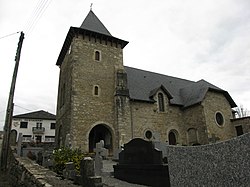
In the mid 15th century, Soule finally recognizes theKing of Franceas its own, with the Basque district becoming the smallest province and exclave of the kingdom and the most distant from the centre of power,Paris.It came to be surrounded by the sovereignKingdom of Navarreon the south and west and the independent principality ofViscounty of Béarnon the east. In 1511, King Francis I of France urged the Souletins to set down theirinstitutional and legal frameworkon paper, which they did inBearnese,the administrative written language up to that point. In 1539, an amendment to their region specific laws went on to be written in French, the new official language as decreed by King Francis I. Despite numbering more than fifty towns and villages, Soule was populated by fewer than 4,000 people. The only town wasMauléon,with a population totalling fewer than 350 people. As of 1512, given its proximity to France and its particular geographic situation surrounded by the Kingdom of Navarre-Bearn and therecently invaded Navarreto the south, Soule became ensnared in the political, religious and military manoeuvres derived from its shaky position, with theFrench Wars of Religionaffecting the province tremendously.
The end of home rule
[edit]
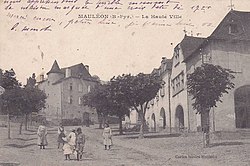
The province of Soule relied largely on the commons set on the highlands and lowlands of the valley for the use of local farmers and shepherds. However, they were also coveted by local and alien lords with estate grants on Soule. By the mid 17th century and in the context of theTreaty of the Pyrenees,anger spread like fire among common Souletins at the aristocracy's takeover of lands and the curtailment of their legal and institutional sovereignty. In 1661,a widespread rebellion eruptedled by the priest Bernard Goihenetche 'Matalaz', but was harshly suppressed by an army sent over from Gascony.
Still Soule managed to retain many native laws and institutions, with its representatives attending theParliament of Navarre and Béarn(six deputies, two for each estate). The representatives of Soule in theNational Costituent Assemblyheld in Paris (August 1789) voted against the suppression ofthe French provincesand the establishment of a new administrative arrangement that wiped out the existence of their native order, giving way to thedépartémentsystem.
Attempts by theBasque deputies in Paristo create a Basque department failed, their districts merged withBéarnamong protests of the Basque representatives, and even Soule was divided into two cantons. After the end of theFirst Carlist Warin Spain and the relocation of customs to the Pyrenees from the Ebro (1841), trade withNavarrecollapsed. In the late 19th century, the establishment ofespadrillefactories inMauleónmade up for the decay of economic life and emigration, with a number of inhabitants in Navarre and Aragón pouring in and being recruited on the workforce.
Geography
[edit]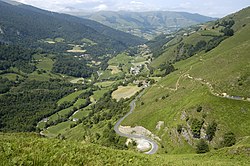
Soule is located in the northern basin of the westernPyrenees,and is the smallest of theBasque region.It is surrounded byLower Navarreon the west,Navarreon the south,Béarnon the east and north. Along withLabourdand Lower Navarre, it forms theNorthern Basque Country,also known as French Basque Country orPays basque.Its entire territory extends around the axis provided by the riverSaison,known in Basque as Uhaitza, that flows from south to north until it joins the riverOloron,that works as a border between Soule and Béarn.
Soule includes three geographical regions: the lowlands at north on a territory known asPettaraor Lower Soule, a forest region known asArbailaand the highlands at south, in a region namedBasabürüawith a highest peak at 2,017 meters (6,617 feet) at thePic d'Orhy.
Orography
[edit]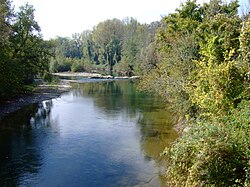
Soule's orography divides into three regions: the northern lowlands, made up by extensive plains; the central region, which is fairly hilly and the southern highlands, which are part of the northwesternPyrenees,with altitudes reaching up to 2,017 meters (6,617 feet) above sea level at the Pic d'Orhy.
In thePyrenees,from west to east, the first peak is thePic d'Orhy,above 2,000 meters (6,600 feet) and the fourth highest peak in the Basque Country afterIror Errege Maiaand Euzkarre among others, all of them in Navarre. Also in the highlands are located the Otsogorrigaina (1,922 metres (6,306 feet) and Sardekagaina (1,893 metres (6,211 feet), which are the second and third highest mountains in Soule. In total, there exist more than 20 peaks higher than 1,000 metres (3,300 feet).
Hydrography
[edit]The riverSaison(known as Ühaitza in Souletin Basque) is the main river of Soule. It is 60 km (37 mi) long and originates at Licq, in the highlands region. Smaller rivers rising at the Pyrenees join the Saison before it converges with the river Oloron, together flowing into the riverAdour.
Climate
[edit]Theoceanic climateof Soule is generally warm and humid. The highlands and Pyrenees experience analpine climate.
Demography
[edit]Soule is the province with the lowest population density of the Northern Basque Country, with 17 people per square kilometer (44 people/sq mi). Soule has experienced a significant population decline since the 19th century; many people have emigrated to larger cities and regions outside the province, such asLabourd,BéarnandParis.In the last century, Soule has lost more than three quarters of its population, which has caused the need for different municipalities to be merged in order to assure the maintenance of public services.
Largest cities
[edit]| Most populated communes [3] | |||||||
|---|---|---|---|---|---|---|---|
| Position | Name | Inhabitants | |||||
| 1st | Mauléon-Licharre(Maule-Lextarre) | 3,347 | |||||
| 2nd | Chéraute(Sohüta) | 1,104 | |||||
| 3rd | Barcus(Barkoxe) | 774 | |||||
| 4th | Viodos-Abense-de-Bas(Bildoze-Onizepea) | 743 | |||||
| 5th | Tardets-Sorholus(Atharratze-Sorholüze) | 590 | |||||
Administrative divisions
[edit]
Traditionally, Soule has been divided into three geographical regions, each of which group a determinate number of municipalities orcommunes.
- Pettarra,[4]comprising the lower Soule, in the north. It includes the towns and villages ofAinharp,Aroue-Ithorots-Olhaïby,Berrogain-Laruns,Domezain-Berraute,Espès-Undurein,Etcharry,Gestas,L'Hôpital-Saint-Blaise,Lohitzun-Oyhercq,Mauléon-Licharre,Moncayolle-Larrory-Mendibieu,Osserain-Rivareyte,Viodos-Abense-de-Bas.[5]
- Arbaila,[6]in the mid-lands. It is divided into two regions:Arbaila Txipia( "small Arbaila" ) andArbaila Handia( "big Arbaila" ). It includes the towns and villages ofAussurucq,Garindein,Gotein-Libarrenx,Idaux-Mendy,Menditte,Musculdy,Ordiarp,Ossas-Suhare,Pagolle,Roquiague,Sauguis-Saint-Étienne.[7]
- Basabürua,[8]comprising the highlands and Pyrenees. It is divided into two regions:Ibarresküin( "the right valley" ) andIbarrezker( "the left valley" ). It includes the towns and villages ofAlçay-Alçabéhéty-Sunharette,Alos-Sibas-Abense,Barcus,Camou-Cihigue,Esquiule,Etchebar,Haux,Lacarry-Arhan-Charritte-de-Haut,Laguinge-Restoue,Larrau,Lichans-Sunhar,Licq-Athérey,Montory,Sainte-Engrâce,Tardets-Sorholus,Trois-Villes.[9]
For administrative purposes, the communes of Soule are grouped into fourcantons;the canton ofMauléon-Licharre,that includes 19 communes; the canton ofTardets-Sorholus,that includes 16 communes; the canton ofSaint-Palaisand the canton of Oloron.[3]
Culture
[edit]After decades of emigration and demographic, social and cultural decay, the territory is showing a strong determination to recover the lost vitality of centuries ago. Assorted cultural events linked to old traditions bear witness to that dynamism.
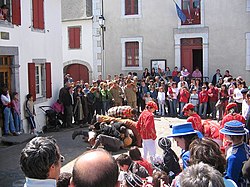
There is a tradition of folk musical theatre, thepastoral:the inhabitants of a village spend the year preparing and rehearsing the play and its dances. Traditionally, the subject of the play was Catholic, but recently pieces of Basque history are also presented. Another event akin to the pastoral beloved of the people of Soule is themaskaradas.This theatrical performances are put on in many villages of Soule in carnival time through spring. Each year a specific village takes the responsibility of arranging a new performance. It consists of a music band in due carnival outfit surrounded with a group of set carnivalesque characters and dancers parading up and down the main street of the host village; at the end, they stage an informal play usually in the market place or handball court.[10]
Soule is also renowned for its singing tradition, elegant dances and local music instruments, such asxirulaandttun-ttun.These instruments are gaining new dynamism thanks to music schools founded to that end by local cultural activists.[11]
Language
[edit]Soule's own language has beenBasquefor centuries, with the region featuring its ownSouletindialect. At the same time, the neighbouringBéarnais(Gascon) has been widely understood, and in recent centuries even spoken as alingua franca.However, both Basque and Béarnais have lost ground toFrenchwith both languages struggling to survive into the next generation. Basque is attested to have been widespread farther east of the territory into the Pyrenees in previous centuries.
The inhabitants call non-Basque speaking foreignersKaskoinak,while other Basque speaking people (especially when referring to those of theFrench Basque Country) are dubbedManexakafter a commonplace sheep breed in the area.
References
[edit]- ^Jacques Lemoine,Toponymie du Pays Basque Français et des Pays de l'Adour,Picard 1977,ISBN2-7084-0003-7
- ^La mort du duc Arembert en Soule massacré par les Basques en 636
- ^abJean-Louis Davant:«Errolda: zonbat züberotar?»Archived2012-01-29 at theWayback Machine
- ^PettarraAuñamendi Eusko Entziklopedia.
- ^Pettarra (Zuberoa (-a)):place names in the website of the Basque language academy
- ^ArbaillesAuñamendi Eusko Entziklopedia.
- ^Arbaila(Zuberoa (-a)):place names in the website of the Basque language academy.
- ^BasabürüaAuñamendi Eusko Entziklopedia.
- ^Basabürüa (Zuberoa (-a)):Place names in the website of the Basque language academy.
- ^"Zuberoko maskarada (pastorale)"(in French). Abarka.Retrieved2011-12-24.
- ^"Mixel Etxekopar & François Rossé - Une certaine Soule musique"(in French). Ethnotempos. Archived fromthe originalon 2011-07-27.Retrieved2008-01-28.



